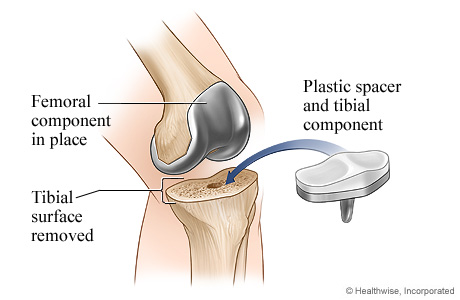knee replacement surgery
normal knee joint

slide 1 of 6
slide 1 of 6, normal knee joint,
inside a normal knee joint, thick cushioning (cartilage) covers and protects the ends of your bones. this is called hyaline cartilage. another type of cartilage, called meniscal cartilage or meniscus, acts like a shock absorber between the bones and keeps the knee joint stable by spreading out the load evenly across the joint. the two menisci (plural of meniscus) protect and cushion the surface of the joint and the ends of your bones.
osteoarthritis of the knee

slide 2 of 6
slide 2 of 6, osteoarthritis of the knee,
in osteoarthritis, the cartilage that protects and cushions the knee joint breaks down over time. as the cartilage wears down, the bone surfaces rub against each other. this damages the tissue and bone, causing pain. osteoarthritis is common in the knee joints.
femoral component is placed

slide 3 of 6
slide 3 of 6, femoral component is placed,
removal of damaged cartilage and bone from the lower end of the femur and placement of the femoral component
tibial component is placed

slide 4 of 6
slide 4 of 6, tibial component is placed,
removal of damaged cartilage and bone from the upper end of the tibia and placement of the tibial component
patellar component is placed

slide 5 of 6
slide 5 of 6, patellar component is placed,
removal of damaged cartilage and bone from the patella and placement of the patellar component
knee replacement surgery is complete

slide 6 of 6
slide 6 of 6, knee replacement surgery is complete,
completed knee replacement
current as of: july 17, 2023
author: healthwise staff
clinical review board
all healthwise education is reviewed by a team that includes physicians, nurses, advanced practitioners, registered dieticians, and other healthcare professionals.